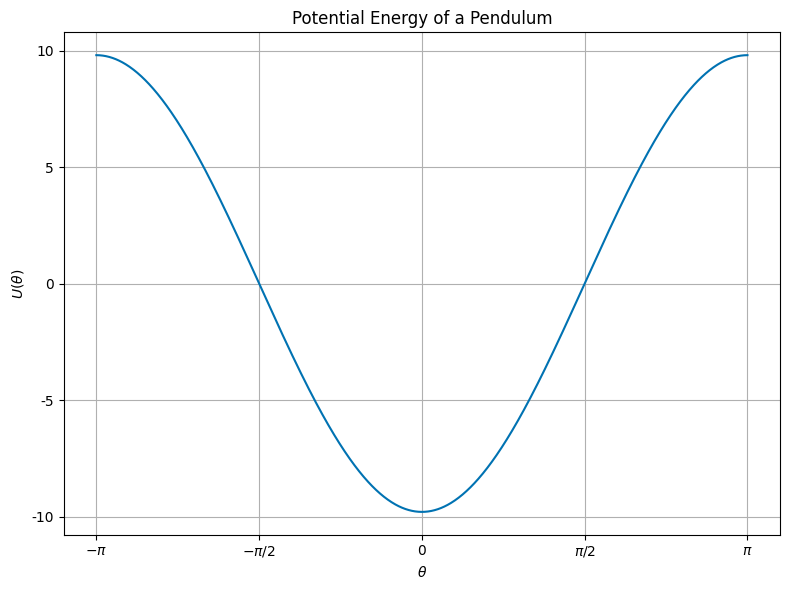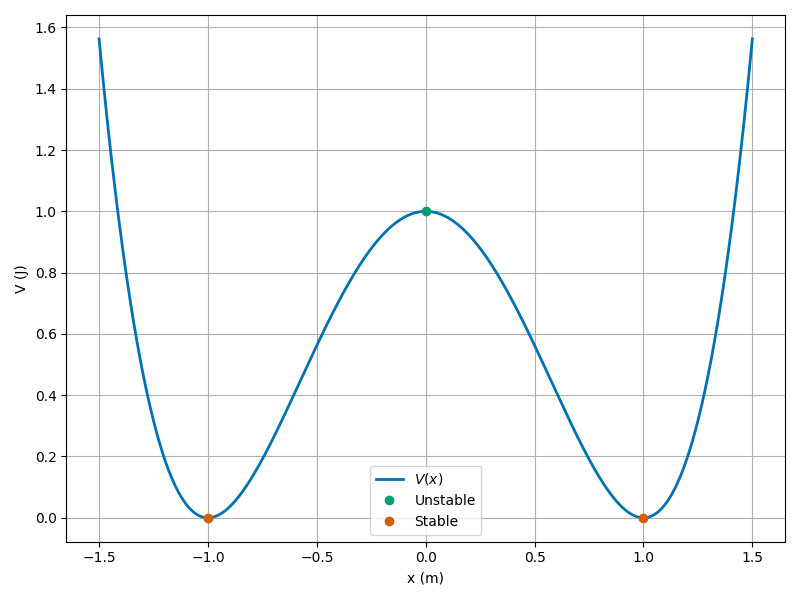Day 15 - Potential Energy and Stability#

Mexican Hat/Sombrero Potential \(\longrightarrow\)
Mexican Hat Potential#
\(V(\phi) = -5|\phi|^2 + |\phi|^4\)

Unstable vacuum state at \(\phi = 0\)
Peak of the hat
Infinite number of stable minima
\(\phi = \sqrt{5/2}e^{i\phi}\)
Announcements#
Midterm 1 is available today (Due Oct 10th)
You may work in larger groups, but solutions are submitted like homework
No office hours on Friday (DC traveling)
Seminars this week#
MONDAY, September 29, 2025#
Condensed Matter Seminar 4:10 pm,1400 BPS, In Person and Zoom, Host ~Mark Dykman Speaker: Peter Littlewood, University of Chicago Title: Non-Reciprocal Phase Transitions Zoom Link: https://msu.zoom.us/j/93613644939 Meeting ID: 936 1364 4939 Password: CMP
Seminars this week#
TUESDAY, September 30, 2025#
Theory Seminar, 11:00am., FRIB 1200 lab in person and online via Zoom Speaker: Debora Mroczek, University of Illinois Title: Revealing new phases of matter in neutron stars Please click the link below to join the webinar: Zoom Link: 964 7281 4717 Meeting ID: 48824
Seminars this week#
TUESDAY, September 30, 2025#
High Energy Physics Seminar, 1:30 pm, 1400 BPS, Host~ Joshua Isaacson
Speaker: Tony Menzo, Joint affiliation - FNAL/Univ. of Alabama
Title: The journey towards differentiable hadronization models
Zoom:
Passcode:
(Joining the Zoom meeting requires a password. Please contact one of the organizers, if you haven’t received it.)
Organized by: Joey Huston, Sophie Berkman and Brenda Wenzlick
Seminars this week#
WEDNESDAY, October 1, 2025#
Astronomy Seminar, 1:30 pm, 1400 BPS, In Person and Zoom, Host~ Speaker: Madison Brady, MSU Title: Zoom Link: https://msu.zoom.us/j/93334479606?pwd=OtIXPWhRPBfzYu53sl3trSJlaBYI7C.1 Meeting ID: 933 3447 9606 Passcode: 825824
Seminars this week#
THURSDAY, October 2, 2025#
Colloquium, 3:30 pm, 1415 BPS, in person and zoom. Host ~ Witold Nazarewics Refreshments and social half-hour in BPS 1400 starting at 3 pm Speaker: David Dean, Thomas Jefferson National Accelerator Facility Title: From the quarks to the cosmos Background: For more information and to schedule time with the speaker, see the colloquium calendar at https://pa.msu.edu/news-events-seminars/colloquium-schedule.aspx Zoom Link: https://msu.zoom.us/j/94951062663 Password: 2002
Seminars this week#
FRIDAY, October 3, 2025#
Special Seminar, 10:00am, In Person Only, FRIB 1300 Auditorium Speaker: Sudip Bhattacharyya - Tata Institute of Fundamental Research & Massachusetts Institute of Technology Title: Thermonuclear X-ray bursts: probing neutron stars and a double-photospheric-radius-expansion Sign up to meet with Dr. Bhattacharyya (enter your name and meeting location): https://docs.google.com/spreadsheets/d/1tlw765Lf8mNOeCUJp8cWfSOvQfiF4vJDOuhKKVPXH1M/edit?usp=sharing
Seminars this week#
FRIDAY, October 3, 2025#
QuIC Seminar, 12:30pm, -1:30pm, 1300 BPS, Zoom only Speaker: Balint Pato, Duke University Title: Compass codes in quantum error correction Full Scheule is at: https://sites.google.com/msu.edu/quic-seminar/ For more information, reach out to Ryan LaRose
This Week’s Goals#
Understand the concept of potential energy
Determine the equilibrium points of a system using potential energy
Analyze the stability of equilibrium points
Define and begin to apply conservation of linear and angular momentum
Reminder: The Gradient Operator \(\nabla\)#
\(\nabla\) is a vector operator. In Cartesian coordinates: $\(\nabla = \hat{x}\dfrac{\partial}{\partial x}+\hat{y}\dfrac{\partial}{\partial y}+\hat{z}\dfrac{\partial}{\partial z} = \left\langle \dfrac{\partial}{\partial x}, \dfrac{\partial}{\partial y}, \dfrac{\partial}{\partial z} \right\rangle\)$
Acting on a scalar function \(f(x,y,z)\) produces a vector:
Reminder: The Gradient Operator \(\nabla\)#
\(\nabla\) can act on vector field (function), \(\mathbf{F}(x,y,z)\) with both dot and cross products.
Divergence (Scalar Product)#
How does the vector field change in the direction of the vector?
Clicker Question 15-1a#
Which of the following fields have no divergence?
 B.
B. 
A
B
Both A and B
Neither A nor B
Reminder: The Gradient Operator \(\nabla\)#
\(\nabla\) can act on vector field (function), \(\mathbf{F}(x,y,z)\) with both dot and cross products.
Curl (Vector Product)#
How does the vector field change in the direction perpendicular to the vector?
Clicker Question 15-1b#
Which of the following fields have no curl?
 B.
B. 
A
B
Both A and B
Neither A nor B
Clicker Question 15-1c#
Consider a vector field with zero curl: \(\nabla \times \vec{F} = 0\). Which of the following statements is true?
The field is conservative
\(\int \nabla \times \vec{F} \cdot d\vec{A} = 0\)
\(\oint \vec{F} \cdot d\vec{r} \neq 0\)
\(\vec{F}\) is the gradient of some scalar function, e.g., \(\vec{F} = - \nabla U\)
Some combination of the above
Reminders: Conservative Forces#
Conservative forces are those with zero curl
The work done by a conservative force is path-independent; on a closed path, the work done is zero
The force can be written as the gradient of a scalar potential energy function
Clicker Question 15-2#
Here’s the graph of the potential energy function \(U(x)\) for a pendulum.

What can you say about the equilibrium points? There is/are:
One stable point
Two stable points
One stable and one unstable point
Two unstable and one stable point
Clicker Question 15-3#
Here’s a potential energy function \(U(x)\) for a pendulum:
Find the equilibrium points (\(\phi^*\)) of the pendulum by setting:
Characterize the stability of the equilibrium points (\(\phi^*\)) by examining the second derivative:
Click when done.
Clicker Question 15-4#
A double-well potential energy function \(U(x)\) is given by
We assume we have scaled the potential energy so that all the units are consistent.
How many equilibrium points does this system have?
1
2
3
4
Clicker Question 15-5#
A double-well potential energy function \(U(x)\) is given by
Find the equilibrium points (\(x^*\)) of the pendulum by setting:
Characterize the stability of the equilibrium points (\(x^*\)) by examining the second derivative:
Click when done.
Clicker Question 15-6#
Here’s a graph of the potential energy function \(U(x)\) for a double-well potential.

Describe the motion of a particle with the total energy, \(E=\)
\(0.4\,\mathrm{J}\), \(<\) barrier height
\(1.2\,\mathrm{J}\), \(>\) barrier height
\(1.0\,\mathrm{J}\), \(=\) barrier height
Click when done.
